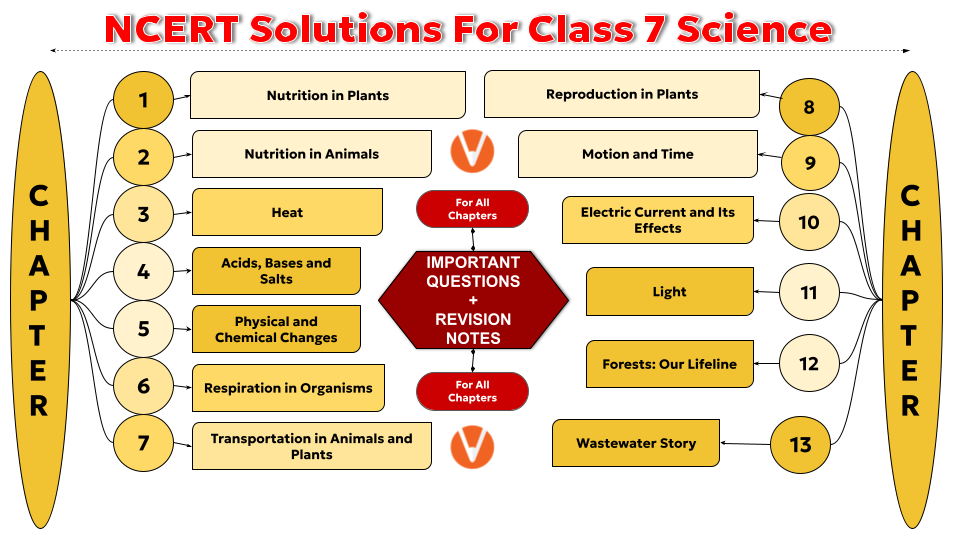Chapter-wise Class 7 Science Questions and Answers Free PDF Download
FAQs on NCERT Solutions For Class 7 Science All Chapters - 2025-26
1. How many chapters are there in the Class 7 Science NCERT textbook for the 2025-26 session?
For the academic year 2025-26, the rationalised CBSE Class 7 Science NCERT textbook contains a total of 13 chapters. The NCERT Solutions cover all the in-text and end-of-chapter exercises for each of these chapters, ensuring complete syllabus coverage.
2. What are the key features of reliable NCERT Solutions for Class 7 Science?
High-quality NCERT Solutions for Class 7 Science are characterised by several features:
Step-by-step methodology: Each answer is broken down into logical steps, making complex problems easy to understand.
Syllabus Alignment: Solutions are strictly based on the latest CBSE 2025-26 guidelines and curriculum.
Expert Verification: Answers are prepared and reviewed by subject matter experts for accuracy and correctness.
Clarity and Simplicity: The language used is simple and clear, helping students to grasp the core concepts effectively.
3. How can using NCERT Solutions help in preparing for the Class 7 Science exam?
Using NCERT Solutions is a crucial part of exam preparation. They help students understand the correct method to frame answers as per CBSE standards. By practising with these solutions, students can identify common mistakes, manage their time better by learning efficient problem-solving techniques, and build confidence by mastering the questions given in their textbook.
4. Are the NCERT Solutions for Class 7 Science available for each chapter individually?
Yes, comprehensive NCERT Solutions are structured chapter-wise. This allows students to focus on a specific chapter they are studying, solve its exercises, and clarify doubts without having to search through a single large document. This organised approach helps in systematic revision and targeted practice for all 13 chapters.
5. Why is it important to follow the step-by-step method provided in the NCERT Solutions?
Following the step-by-step method is critical not just for getting the right answer, but for learning the scientific process. In exams, marks are often allocated for specific steps, especially for numerical problems in chapters like 'Heat' or 'Motion and Time'. This approach ensures you demonstrate a clear understanding of the concept and don't lose marks for an incomplete or poorly explained answer.
6. Can NCERT Solutions help clarify concepts, or are they just for checking final answers?
While they are excellent for verifying answers, well-crafted NCERT Solutions are primarily a learning tool. They are designed to explain the 'how' and 'why' behind each question. For instance, the solution to a question on 'Acids, Bases and Salts' will not just state the answer but also explain the underlying chemical reaction or principle, thereby reinforcing conceptual understanding.
7. Which chapters in Class 7 Science are most important for building a strong foundation for higher classes?
Several chapters in Class 7 Science are fundamental for concepts in Classes 8, 9, and 10. Key foundational chapters include:
Chapter 4: Acids, Bases and Salts: Forms the basis of Chemistry.
Chapter 9: Motion and Time: Introduces core concepts of Physics.
Chapter 10: Electric Current and its Effects: Essential for understanding electricity in later classes.
Chapter 11: Light: Lays the groundwork for optics.
Using NCERT solutions for these chapters ensures a solid conceptual base.
8. How do NCERT Solutions address the practical and activity-based questions in the Class 7 Science textbook?
NCERT Solutions provide detailed explanations for the observations and conclusions of the textbook's activities. For example, for an activity in the 'Physical and Chemical Changes' chapter, the solution will explain what changes are observed (e.g., colour change, gas evolution) and correctly classify it as a physical or chemical change, along with the scientific reasoning. This helps connect theoretical knowledge with practical application.

























